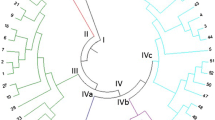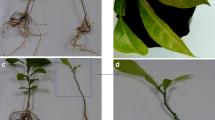Abstract
In this study, 115 isolates of Fusarium oxysporum from roots of Agave tequilana Weber cv azul plants and soil in commercial plantations in western Mexico were characterized using morphological and molecular methods. Genetic analyses of monosporic isolates included restriction enzyme analysis of rDNA (ARDRA) using HaeIII and HinfI, and genetic diversity was determined using Box-PCR molecular markers. Box-PCR analysis generated 14 groups. The groups correlated highly with the geographic location of the isolate and sample type. These results demonstrate the usefulness of ARDRA and Box-PCR techniques in the molecular characterization of the Fusarium genus for the discrimination of pathogenic isolates.






Similar content being viewed by others
References
Arizaga S, Ezcurra E (1995) Insurance against reproductive failure in a semelparous plant: bulbil formation in Agave macroacantha flowering stalks. Oecologia 101:329–334
Berg G, Zachow Ch, Lottmann J, Götz M, Costa R, Smalla K (2005) Impact of plant species and site on rhizosphere associated fungi antagonistic to Verticillium dahlia Kleb. Appl Environ Microbiol 71:4203–4213
Correll JC (1991) The relationship between Formae speciales, races and vegetative groups. Phytopathology 81:1061–1064
CRT (2010). Actualización de la base de datos y diagnostico fitosanitario de Agave tequilana Weber var. azul en la denominación de origen tequila. http://www.crt.org.mx/images/documentos/inventarioagave2010b.pdf
García-Mendoza AJ (2007) Los agaves de México. Ciencias 87:14–23
Gerlach W, Nirenberg HI (1982) The genus Fusarium: a pictorial atlas. Mitt Biol Bundesanst Land-u Forstwirsch Berlin-Dahlem 209:1–406
Gil-Vega K, González-Chavira M, Martínez de la Vega O, Simpson J, Vandermark G (2001) Analysis of genetic diversity in Agave tequilana var. Azul using RAPD markers. Euphytica 119:335–341
Komada H (1976) A new selective medium for isolating Fusarium from natural soil. Proc Amer Phytopathol Soc 3:221
Lee SB, Taylor JW (1990) Isolation of DNA from fungal mycelia and single spores. In: Innis MA, Gelfand DH, Shinsky J, White TJ (eds) PCR protocols: a guide to methods and application, Chap 34, Academic, San Diego, pp 282–287
Leong SK, Latiffah Z, Baharuddin S (2010) Genetic diversity of Fusarium oxysporum f. sp. cubense isolates from Malaysia. Afr J Microbiol Res 4:1026–1037
Luna-Hernández G (1996) Pudrición del tallo de Agave tequilana Weber, var. azul en el estado de Jalisco, México. Tesis de Licenciatura, Universidad Autónoma de Chapingo
Nash SM, Snyder WC (1962) Quantitative estimations by plate counts of propagules of bean root rot Fusarium in field soils. Phytopathology 52:567–572
Nelson PE, Toussoun TA, Marassas WFO (1983) Fusarium species: an illustrated manual for identification. Pennsylvania State University Press, University Park p 193
Nirenberg HI (1976) Untersuchungen über die morphologische und biologische differenzierung in der Fusarium-Section Liseola. Mitt Biol Bund Land-Forstwirt Berlin-Dahlem 169:1–117
Oliveira VC, Costa JL da S (2002). Restriction analysis of rDNA (ARDRA) can differentiate Fusarium solani f. sp. phaseoli from F. solani f. sp. glycines. Fitopatologia Brasileria 27:631–634
Promputtha I, Lumyong S, Dhanasekaran V, McKenzie EHC, Hyde KD, Jeewon R (2006) A Phylogenetic evaluation of whether endophytes become saprotrophs at host senescence. Microb Ecol 53:579–590
Rohlf FJ (2000) NTsys-PC: numerical taxonomy and multivariate analysis system. Version 2.1. Exeter, New York, USA. p 189
Rubio CR (2007) Enfermedades del cultivo de agave. Conocimiento y prácticas agronómicas para la producción de Agave tequilana Weber en la zona con denominación de origen del tequila. Instituto Nacional de Investigadores Forestales y pecuarias. Centro de Investigación Regional Pacífico Centro. Libro técnico 4:169–195
White TJ, Bruns TD, Lee S, Taylor JW (1990) Amplification and direct sequencing of fungal ribosomal RNA genes for phylogenetics. In: Innis MA, Gelfand DH, Shinsky J, White TJ (eds) PCR protocols: A guide to methods and applications. Academic, New York, pp 315–322
Acknowledgments
We would like to thank the DGEST for partial financial assistance. Thanks also to Dr. M. A. Apodaca Sanchez at Universidad Autónoma de Sinaloa for proved FOL and FORL isolates and Mike Davis of the University of California for critical reading of the manuscript. This study forms part of the master’s degree of the first author in UABC.
Author information
Authors and Affiliations
Corresponding author
Rights and permissions
About this article
Cite this article
Vega-Ramos, K.L., Uvalle-Bueno, J.X. & Gómez-Leyva, J.F. Molecular Variability among Isolates of Fusarium oxysporum Associated with Root Rot Disease of Agave tequilana . Biochem Genet 51, 243–255 (2013). https://doi.org/10.1007/s10528-012-9559-4
Received:
Accepted:
Published:
Issue Date:
DOI: https://doi.org/10.1007/s10528-012-9559-4




